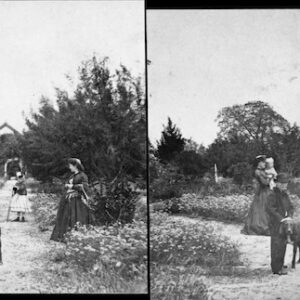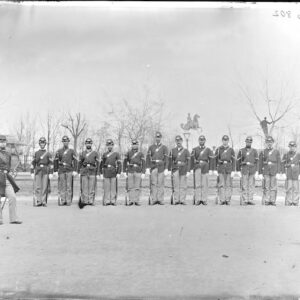Tag: hoop and stick
 Wikipedia says: Hoop rolling, also called hoop trundling, is both a sport and a child’s game in which a large hoop is rolled along the ground, generally by means of an object wielded by the player. The aim of the game is to keep the hoop upright for long periods of time, or to do various tricks.
Wikipedia says: Hoop rolling, also called hoop trundling, is both a sport and a child’s game in which a large hoop is rolled along the ground, generally by means of an object wielded by the player. The aim of the game is to keep the hoop upright for long periods of time, or to do various tricks.
Hoop rolling has been documented since antiquity in Africa, Asia and Europe. Played as a target game, it is an ancient tradition widely dispersed among different societies. In Asia, the earliest records date from Ancient China, and in Europe from Ancient Greece.
In the West, the most common materials for the equipment have been wood and metal. Wooden hoops, driven with a stick about one foot long, are struck with the centre of the stick in order to ensure good progress. Metal hoops, instead of being struck, are often guided by a metal hook.
A version of hoop rolling played as a target game is encountered as an ancient tradition among aboriginal peoples in many parts of the world. The game, known as hoop-and-pole, is ubiquitous throughout most of Africa. It is also found on other continents. In the Americas, where it has been played by a great number of unrelated tribes and is known in English as hoop-and-stick or hoop-and-dart, the game has exhibited many variations of materials and size of implements and rules of play. It is postulated that its wide distribution is a factor of the rich symbolical possibilities of the game, rather than indicating radial diffusion from a single center of invention.
The Greeks referred to the hoop as the “trochus”. Hoop rolling was practiced in the gymnasium, and the prop was also used for tumbling and dance with different techniques. Although a popular form of recreation, hoop rolling was not featured in competition at the major sports festivals.
Hoops, also called krikoi, were probably made of bronze, iron, or copper, and were driven with a stick called the “elater”. The hoop was sized according to the player, as it had to come up to the level of the chest. Greek vases generally show the elater as a short, straight stick. The sport was regarded as healthful, and was recommended by Hippocrates for strengthening weak constitutions. Even very young children would play with hoops.
The hoop thus held symbolic meanings in Greek myth and culture. A bronze hoop was one of the toys of the infant Dionysus, and hoop driving is an attribute of Ganymede, often depicted on Greek vase paintings from the 5th century BCE. Images of the hoop are sometimes presented in the context of ancient Greek pederastic tradition.
The Romans learned hoop driving from the Greeks and generally held the sport in high regard. The Latin term for hoop is also “trochus”, at times referred to as the “Greek hoop”. The stick was known as a “clavis” or “radius”, had the shape of a key, and was made of metal with a wooden handle. Roman hoops were fitted with metal rings that slid freely along the rim. According to Martial, this was done so that the tinkling of the rings would warn passers by of the hoop’s approach: “Why do these jingling rings move about upon the rolling wheel? In order that the passers-by may get out of the way of the hoop.”(14. CLXIX) He also indicates that the metal tires of wooden cart wheels could be used as hoops: “A wheel must be protected. You make me a useful present. It will be a hoop to children, but to me a tyre for my wheel.”(14. CLXVIII) Martial also mentions the sport was practised by Sarmatian boys, who rolled their hoops on the frozen Danube river. According to Strabo, one of the popular Roman venues for practising the sport was the Campus Martius, which was large enough to accommodate a wide variety of activities.
The Roman game was to roll the hoop while throwing a spear or stick through it. For Romans, this was more an entertainment and military development, not a philosophical activity. Several ancient sources praise the sport. According to Horace, hoop driving was one of the manly sports. Ovid in his Tristia is more specific, putting the sport in the same category with horsemanship, javelin throwing and weapon practice: “Usus equi nunc est, levibus nunc luditur armis, Nunc pila, nunc celeri volvitur orbe trochus.” It was also presented as a virtue in the Distichs of Cato, which enjoin youth to “Trocho lude; aleam fuge” (“Play with the hoop, flee the dice”). A 2nd-century medical text by Antyllus, preserved in an anthology of Oribasius, Emperor Julian’s physician, describes hoop rolling as a form of physical and mental therapy. Antyllus indicates that at first the player should roll the hoop maintaining an upright posture, but after warming up he can begin to jump and run through the hoop. Such exercises, he holds, are best done before a meal or a bath, as with any physical exercise.
Early 19th-century travellers saw children playing with hoops over much of Europe and beyond.
The game was also a common pastime of African village children on the Tanganyika plateau, and not long after it is recorded in the Freetown settler community. In China, the game may well go back to 1000 BC or further. Christian missionaries encountered it there in the 19th century. Children in late Edo period Japan also were known to play the game.
In English the sport is known by several names, “hoop and stick“, “bowling hoops”, or “gird and cleek” in Scotland, where the gird is the hoop and the cleek, the stick.
In the west, around the end of the 19th century, the game was played by boys up to about twelve years of age. Hoops would at times have pairs of tin squares nailed to the inside of the circle, to jingle as the hoop was rolled. Up to a dozen such pairs of rattles might be placed around the rim of the hoop. Some preferred the ashen hoops, round on the outside and flat on the inside, to the ones made of iron, as the latter could break windows and hurt the legs of the passers by and horses.
Showing all 5 resultsSorted by latest




